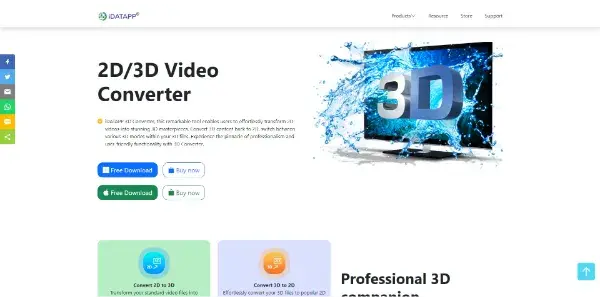2D&3D Video Converter

Easily convert your 2D videos into immersive 3D experiences with a professional, user-friendly tool
Revolutionizing Video Experience: A Deep Dive into 2D&3D Video Converter AI Tools
The landscape of video consumption is rapidly evolving, with immersive 3D experiences gaining significant traction. However, the process of converting existing 2D video content into 3D often requires specialized knowledge and expensive software. This is where AI-powered 2D&3D video converter tools emerge as a game-changer, offering a simple yet effective solution for transforming standard videos into compelling 3D presentations. This article examines the capabilities, applications, and comparative advantages of these emerging AI tools, focusing on those offering a free tier.
What Does a 2D&3D Video Converter AI Tool Do?
A 2D&3D video converter AI tool leverages artificial intelligence to automatically convert two-dimensional video footage into three-dimensional representations. This is achieved through sophisticated algorithms that analyze the video's depth, textures, and motion, generating a stereoscopic 3D effect. Unlike traditional methods which often require manual intervention and specialized equipment, these AI tools streamline the process, making it accessible to a wider audience. The conversion typically involves creating a separate image stream for each eye, mimicking the way human vision perceives depth.
Main Features and Benefits
A robust 2D&3D video converter AI tool should offer the following key features:
- Automatic Conversion: The core benefit lies in the automation of the conversion process. Users simply upload their 2D video, and the AI handles the complex conversion tasks.
- High-Quality Output: The algorithm should be optimized to produce 3D videos with minimal artifacts and distortions, preserving the original video quality as much as possible.
- User-Friendly Interface: Intuitive design and easy navigation are crucial for accessibility. The tool should be straightforward to use, even for users without prior experience in video editing or 3D technologies.
- Various Output Formats: Support for multiple 3D video formats (e.g., Side-by-Side, Top-Bottom) ensures compatibility with diverse playback devices.
- Batch Processing: The ability to convert multiple videos simultaneously saves significant time and effort.
- Resolution Options: Allowing users to select their desired output resolution provides control over file size and quality.
The benefits include:
- Reduced Costs: Eliminates the need for expensive software or professional services.
- Increased Engagement: 3D video offers a more immersive and engaging viewing experience.
- Enhanced Storytelling: 3D can significantly enhance the impact of storytelling in various applications.
- Accessibility: Makes 3D video production accessible to individuals and smaller businesses.
Use Cases and Applications
The applications of 2D&3D video converter AI tools are diverse and span various industries:
- Entertainment: Converting home videos, travel footage, or personal projects into 3D for enhanced viewing.
- Education: Creating more engaging educational materials by transforming lectures, documentaries, or training videos into 3D.
- Marketing & Advertising: Enhancing the impact of product demonstrations, commercials, and virtual tours through 3D.
- Real Estate: Creating immersive virtual tours of properties to showcase them more effectively.
- Gaming: Converting gameplay footage into 3D for a more captivating viewing experience.
Comparison to Similar Tools
Many tools offer 2D to 3D video conversion, but AI-powered options distinguish themselves through automation and ease of use. Traditional software often requires manual adjustments, depth map creation, and significant technical expertise. AI-based tools offer a more streamlined, automated process, making the technology accessible to a much broader user base. The key difference lies in the level of user intervention required and the resulting quality of the 3D output. A comparison of specific tools would require a detailed review of individual platforms, focusing on factors like output quality, processing speed, and feature set.
Pricing Information
Many 2D&3D video converter AI tools offer a free tier, allowing users to experience the capabilities before considering a paid subscription or per-conversion charges. This free tier often has limitations on video length, resolution, or the number of conversions permitted. Paid versions typically offer increased processing capabilities, higher resolution options, and potentially additional features like advanced editing tools. The specific pricing model varies from tool to tool. For accurate pricing information, it's essential to consult the individual provider's website. However, the availability of a free option is a significant advantage for users wanting to explore the technology without financial commitment.